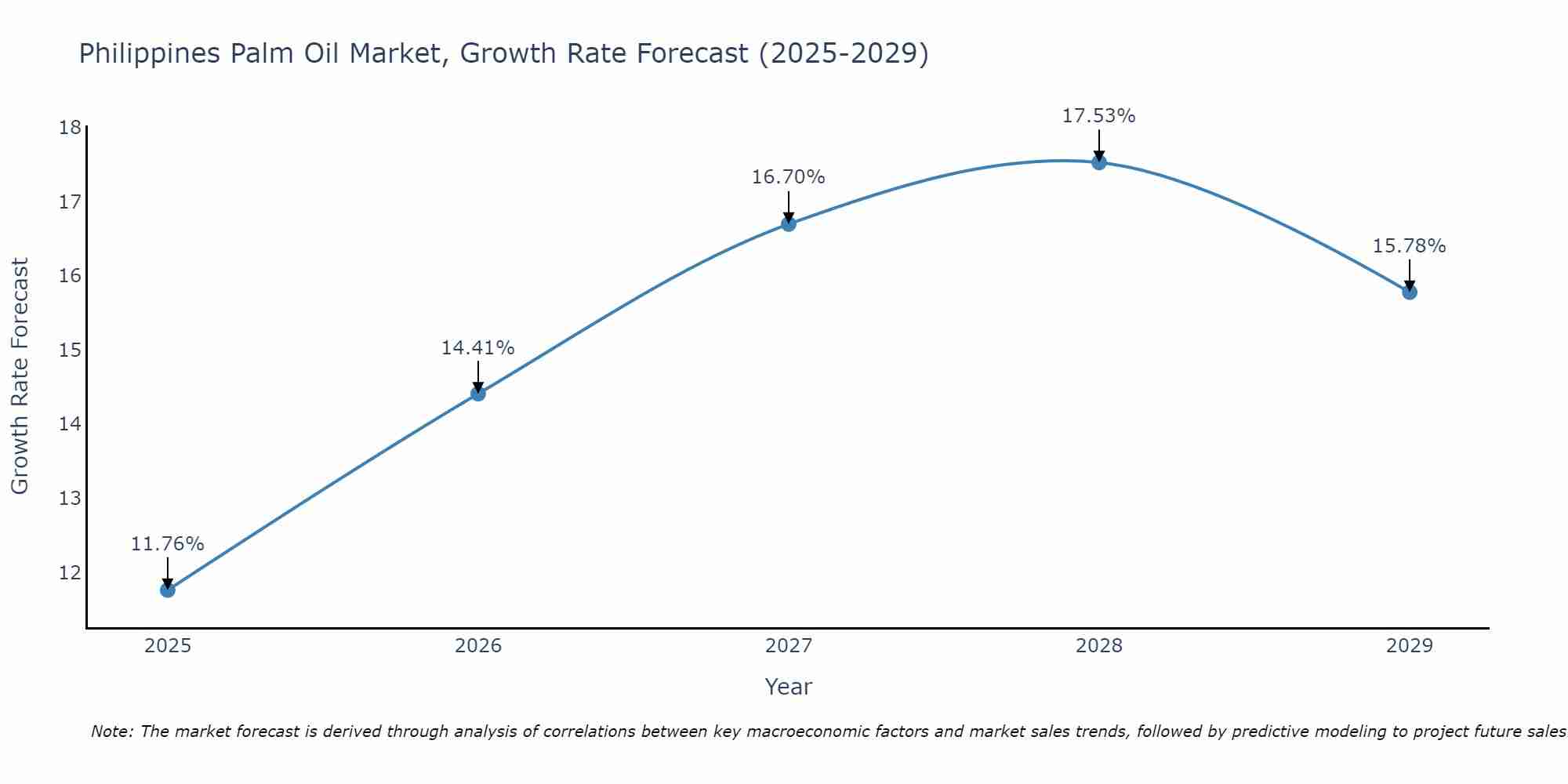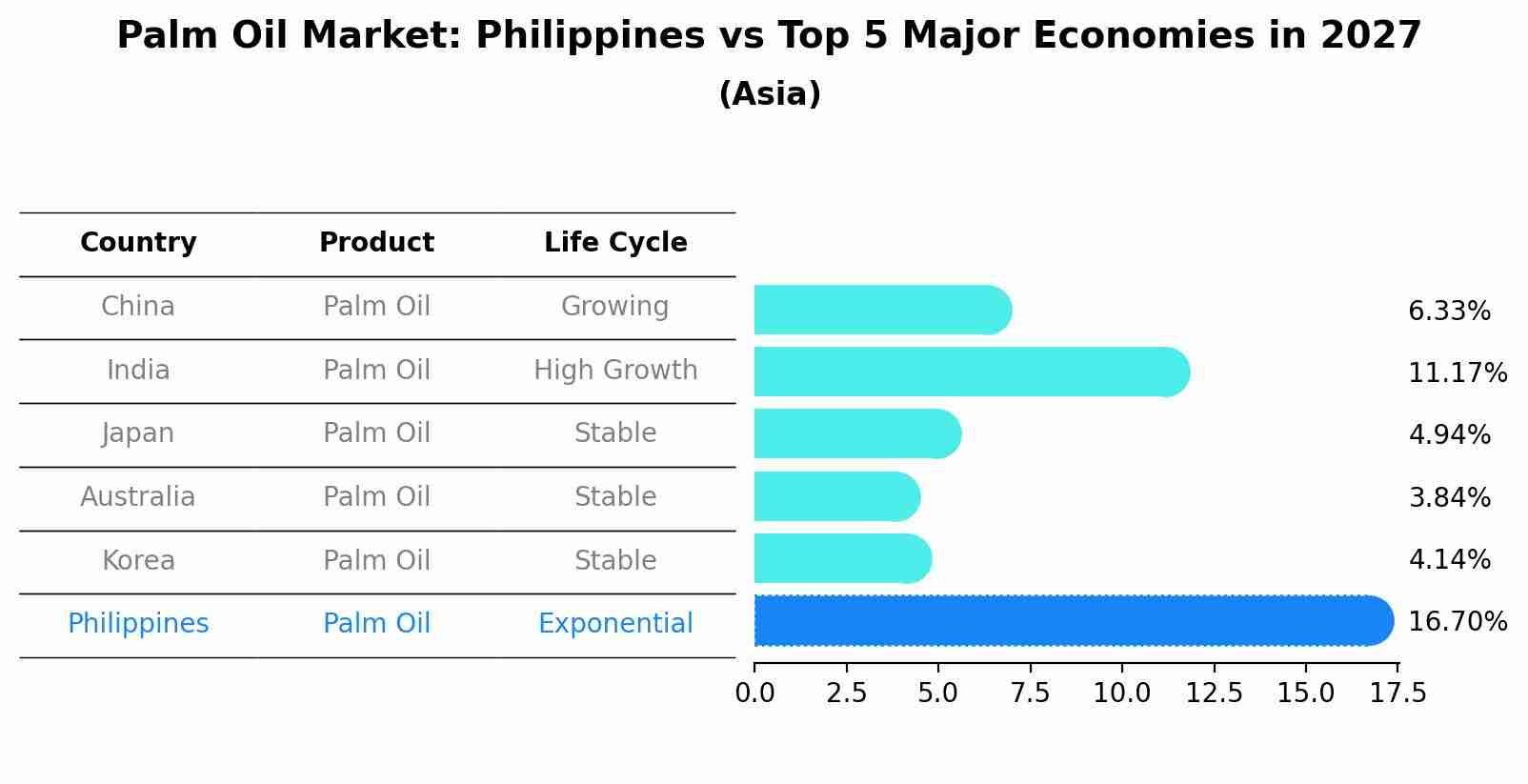Philippines Palm Oil Market (2025-2031) Outlook | Value, Size, Revenue, Growth, Trends, Share, Companies, Industry, Forecast, Analysis
| Product Code: ETC383789 | Publication Date: Aug 2022 | Updated Date: Apr 2025 | Product Type: Market Research Report | |
| Publisher: 6Wresearch | Author: Ravi Bhandari | No. of Pages: 75 | No. of Figures: 35 | No. of Tables: 20 |
Philippines Palm Oil Market Size Growth Rate
The Philippines Palm Oil Market is projected to witness mixed growth rate patterns during 2025 to 2029. Starting at 11.76% in 2025, the market peaks at 17.53% in 2028, and settles at 15.78% by 2029.

Palm Oil Market: Philippines vs Top 5 Major Economies in 2027 (Asia)
Philippines's Palm Oil market is anticipated to experience a exponential growth rate of 16.70% by 2027, reflecting trends observed in the largest economy China, followed by India, Japan, Australia and South Korea.

philippines palm oil market Synopsis
Palm oil is a significant commodity in the Philippines, finding application in both food and non-food industries. The country`s tropical climate is conducive to palm cultivation, enabling it to produce palm oil domestically. While the palm oil market offers economic benefits through exports and domestic consumption, concerns have been raised about its environmental impact, including deforestation and habitat destruction. Sustainable palm oil production practices are gaining importance, with efforts to balance economic gains with ecological preservation and responsible land use.
Drivers of the Market
The Philippines palm oil market is influenced by several key drivers. Palm oil is a versatile and widely used vegetable oil in various industries, including food, cosmetics, and biofuels. The country`s tropical climate provides a suitable environment for palm oil cultivation, contributing to local production. The demand for palm oil has been driven by its cost-effectiveness and functional properties in food processing. However, concerns about deforestation, environmental impact, and sustainable practices have prompted discussions about responsible palm oil sourcing and production. Efforts to address these concerns while meeting industrial demands will shape the future of the Philippines palm oil market.
Challenges of the Market
The Philippines palm oil market faces challenges associated with environmental impact, sustainable practices, and market competition. Palm oil production has been linked to deforestation and habitat loss, raising concerns about its environmental impact. Encouraging sustainable palm oil practices and adhering to environmental regulations is a priority. Market competition from other edible oils, consumer demand for sustainable products, and transparency in the supply chain are challenges that the market needs to address.
COVID-19 Impact on the Market
The Philippines palm oil market faced both positive and negative impacts from the pandemic. While the demand for cooking oil remained stable, the closure of food establishments and disruptions in the supply chain affected palm oil consumption. Moreover, the closure of international trade routes impacted palm oil imports. As consumer behavior shifted towards online shopping and home cooking, the market began to recover, but ongoing uncertainties in supply chain operations influenced the market`s performance.
Key Players in the Market
Palm oil is a widely used commodity in various industries, including food and cosmetics. In the Philippines, Aboitiz Equity Ventures through its subsidiary, Pilmico Foods Corporation, is a significant player in the palm oil sector. The company is involved in palm oil cultivation, processing, and distribution.
Key Highlights of the Report:
- Philippines Palm Oil Market Outlook
- Market Size of Philippines Palm Oil Market, 2024
- Forecast of Philippines Palm Oil Market, 2031
- Historical Data and Forecast of Philippines Palm Oil Revenues & Volume for the Period 2021-2031
- Philippines Palm Oil Market Trend Evolution
- Philippines Palm Oil Market Drivers and Challenges
- Philippines Palm Oil Price Trends
- Philippines Palm Oil Porter's Five Forces
- Philippines Palm Oil Industry Life Cycle
- Historical Data and Forecast of Philippines Palm Oil Market Revenues & Volume By Nature for the Period 2021-2031
- Historical Data and Forecast of Philippines Palm Oil Market Revenues & Volume By Organic for the Period 2021-2031
- Historical Data and Forecast of Philippines Palm Oil Market Revenues & Volume By Conventional for the Period 2021-2031
- Historical Data and Forecast of Philippines Palm Oil Market Revenues & Volume By Product for the Period 2021-2031
- Historical Data and Forecast of Philippines Palm Oil Market Revenues & Volume By CPO for the Period 2021-2031
- Historical Data and Forecast of Philippines Palm Oil Market Revenues & Volume By RBD Palm Oil for the Period 2021-2031
- Historical Data and Forecast of Philippines Palm Oil Market Revenues & Volume By Palm Kernel Oil for the Period 2021-2031
- Historical Data and Forecast of Philippines Palm Oil Market Revenues & Volume By Fractionated Palm Oil for the Period 2021-2031
- Historical Data and Forecast of Philippines Palm Oil Market Revenues & Volume By End-use for the Period 2021-2031
- Historical Data and Forecast of Philippines Palm Oil Market Revenues & Volume By Food & Beverage for the Period 2021-2031
- Historical Data and Forecast of Philippines Palm Oil Market Revenues & Volume By Personal Care & Cosmetics for the Period 2021-2031
- Historical Data and Forecast of Philippines Palm Oil Market Revenues & Volume By Biofuel & Energy for the Period 2021-2031
- Historical Data and Forecast of Philippines Palm Oil Market Revenues & Volume By Pharmaceuticals for the Period 2021-2031
- Historical Data and Forecast of Philippines Palm Oil Market Revenues & Volume By Others for the Period 2021-2031
- Philippines Palm Oil Import Export Trade Statistics
- Market Opportunity Assessment By Nature
- Market Opportunity Assessment By Product
- Market Opportunity Assessment By End-use
- Philippines Palm Oil Top Companies Market Share
- Philippines Palm Oil Competitive Benchmarking By Technical and Operational Parameters
- Philippines Palm Oil Company Profiles
- Philippines Palm Oil Key Strategic Recommendations
Frequently Asked Questions About the Market Study (FAQs):
- Single User License$ 1,995
- Department License$ 2,400
- Site License$ 3,120
- Global License$ 3,795
Search
Thought Leadership and Analyst Meet
Our Clients
Related Reports
- Vietnam System Integrator Market (2025-2031) | Size, Companies, Analysis, Industry, Value, Forecast, Growth, Trends, Revenue & Share
- ASEAN and Thailand Brain Health Supplements Market (2025-2031) | Strategy, Consumer Insights, Analysis, Investment Trends, Opportunities, Growth, Size, Share, Industry, Revenue, Segments, Value, Segmentation, Supply, Forecast, Restraints, Outlook, Competition, Drivers, Trends, Demand, Pricing Analysis, Competitive, Strategic Insights, Companies, Challenges
- ASEAN Bearings Market (2025-2031) | Strategy, Consumer Insights, Analysis, Investment Trends, Opportunities, Growth, Size, Share, Industry, Revenue, Segments, Value, Segmentation, Supply, Forecast, Restraints, Outlook, Competition, Drivers, Trends, Demand, Pricing Analysis, Competitive, Strategic Insights, Companies, Challenges
- Europe Flooring Market (2025-2031) | Outlook, Share, Industry, Trends, Forecast, Companies, Revenue, Size, Analysis, Growth & Value
- Saudi Arabia Manlift Market (2025-2031) | Outlook, Size, Growth, Trends, Companies, Industry, Revenue, Value, Share, Forecast & Analysis
- Uganda Excavator, Crane, and Wheel Loaders Market (2025-2031) | Strategy, Consumer Insights, Analysis, Investment Trends, Opportunities, Growth, Size, Share, Industry, Revenue, Segments, Value, Segmentation, Supply, Forecast, Restraints, Outlook, Competition, Drivers, Trends, Demand, Pricing Analysis, Competitive, Strategic Insights, Companies, Challenges
- Rwanda Excavator, Crane, and Wheel Loaders Market (2025-2031) | Strategy, Consumer Insights, Analysis, Investment Trends, Opportunities, Growth, Size, Share, Industry, Revenue, Segments, Value, Segmentation, Supply, Forecast, Restraints, Outlook, Competition, Drivers, Trends, Demand, Pricing Analysis, Competitive, Strategic Insights, Companies, Challenges
- Kenya Excavator, Crane, and Wheel Loaders Market (2025-2031) | Strategy, Consumer Insights, Analysis, Investment Trends, Opportunities, Growth, Size, Share, Industry, Revenue, Segments, Value, Segmentation, Supply, Forecast, Restraints, Outlook, Competition, Drivers, Trends, Demand, Pricing Analysis, Competitive, Strategic Insights, Companies, Challenges
- Angola Excavator, Crane, and Wheel Loaders Market (2025-2031) | Strategy, Consumer Insights, Analysis, Investment Trends, Opportunities, Growth, Size, Share, Industry, Revenue, Segments, Value, Segmentation, Supply, Forecast, Restraints, Outlook, Competition, Drivers, Trends, Demand, Pricing Analysis, Competitive, Strategic Insights, Companies, Challenges
- Israel Intelligent Transport System Market (2025-2031) | Strategy, Consumer Insights, Analysis, Investment Trends, Opportunities, Growth, Size, Share, Industry, Revenue, Segments, Value, Segmentation, Supply, Forecast, Restraints, Outlook, Competition, Drivers, Trends, Demand, Pricing Analysis, Competitive, Strategic Insights, Companies, Challenges
Industry Events and Analyst Meet
Whitepaper
- Middle East & Africa Commercial Security Market Click here to view more.
- Middle East & Africa Fire Safety Systems & Equipment Market Click here to view more.
- GCC Drone Market Click here to view more.
- Middle East Lighting Fixture Market Click here to view more.
- GCC Physical & Perimeter Security Market Click here to view more.
6WResearch In News
- Doha a strategic location for EV manufacturing hub: IPA Qatar
- Demand for luxury TVs surging in the GCC, says Samsung
- Empowering Growth: The Thriving Journey of Bangladesh’s Cable Industry
- Demand for luxury TVs surging in the GCC, says Samsung
- Video call with a traditional healer? Once unthinkable, it’s now common in South Africa
- Intelligent Buildings To Smooth GCC’s Path To Net Zero


















